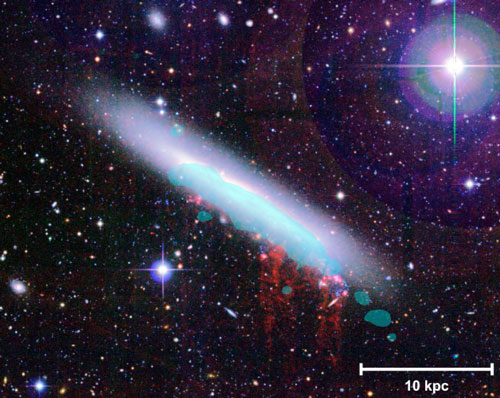| Sep 18, 2019 |
Life and death of the stars: Researchers investigate extreme galaxy environments
|
|
(Nanowerk News) An international team of 30 scientists—led by researchers at McMaster University—is using one of the world’s largest telescopes to investigate and map extreme galaxy environments in brilliant detail.
|
|
Where galaxies live in the Universe, how they interact with their surroundings and with each other is a major influence on star formation over cosmic time. But exactly how the so-called environment dictates the life and death of galaxies is a major focus for astronomers.
|
|
The first ever Canadian-led large program, called the Virgo Environment Traced in CO survey (VERTICO), will be headed by Toby Brown, a postdoctoral fellow in the Department of Physics & Astronomy at McMaster University.
|
 |
| Optical image of spiral galaxy NGC 4330, located in the Virgo Cluster. (Image: Toby Brown, Fossati et al. 2018)
|
|
Dr. Brown and his colleagues will use one of the most advanced telescopes ever built, the Atacama Large Millimeter Array (ALMA) located in the Atacama Desert in Chile, to study the influence of galaxy environments on star formation in the Virgo Cluster, an ideal location for detailed studies of the environment.
|
|
Galaxy clusters are the most extreme environments in the Universe, with huge gravitational forces acting on their member galaxies and super-heated plasma in what is known as the intergalactic medium.
|
|
“Virgo is our nearest massive galaxy cluster and is in the process of forming, which means that we can get a snapshot of galaxies in different stages of their lifecycle,” said Dr. Brown. “This allows us to understand how star formation is shut off in cluster galaxies.”
|
|
Virgo has been studied at almost every wavelength of light, but a millimeter data set with the required sensitivity and resolution does not exist yet. The team will use ALMA to map the star-forming gas, the fuel from which stars are born.
|
|
With the new data, the team will study how the Virgo Cluster environment influences the molecular star-forming gas.
|
|
“One of the ways in which star formation can be stopped, is gas removal or stripping,” Brown explains. “When galaxies pass through the intracluster medium, hot plasma can sweep gas from the galaxies like a huge cosmic broom.”
|
|
Another environmental mechanism is starvation: when molecular gas used in star formation is not replenished and new stars cannot be formed. “This ALMA Large Program allows us to better understand these mechanisms,” he said.
|

